Ficus belongs to the mulberry family, which is an evergreen plant and looks like a tree or shrub. Also, some species grow in the form of creepers. Today we’ll talk about Benjamin's ficus, about leaving at home.
Ficus Benjamin is one of the most common varieties of this genus. They have 12 cm leaves of oblong shape and with different colors. The tree has a voluminous crown covered with gray bark with brown stripes arranged horizontally. In natural conditions, ficus can grow up to 30 meters, but in apartment conditions, its height reaches no more than 5-6 meters.
Content
Benjamin Ficus Care at Home
The plant is not picky for living at home, but still requires compliance with certain standards.
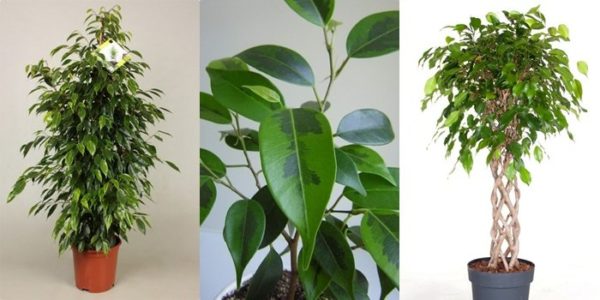
Temperature
The recommended temperature for the ficus should not fall below 16 degrees and rise above 25 degrees. The view has a negative feature - if he does not like something, he begins to discard the foliage and thereby lose its decorative effect. Care at home for the ficus of Benjamin, see the photo.
Humidity
Humidity should be high, since the plant does not tolerate a dry climate. It is recommended to spray it daily at room temperature with water. In winter, this procedure is mandatory, but a little less often.
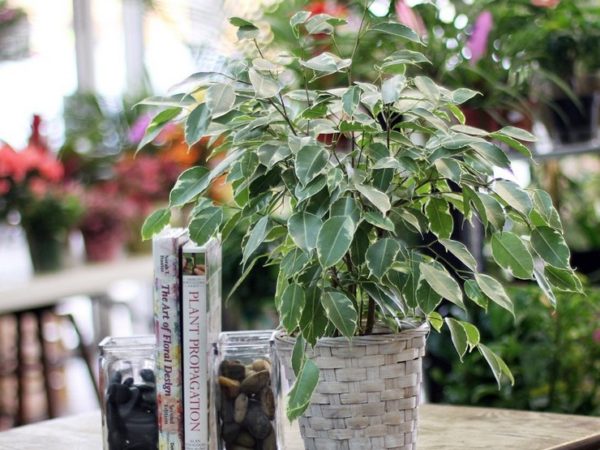
Location and Lighting
The plant is photophilous enough, with insufficient supply of light, the foliage begins to fall. But it is recommended that the lighting be indirect. In the summer, you can put the pot on the balcony, but do it gradually so that the plant has time to get used to the light. In winter, additional lighting is carried out.
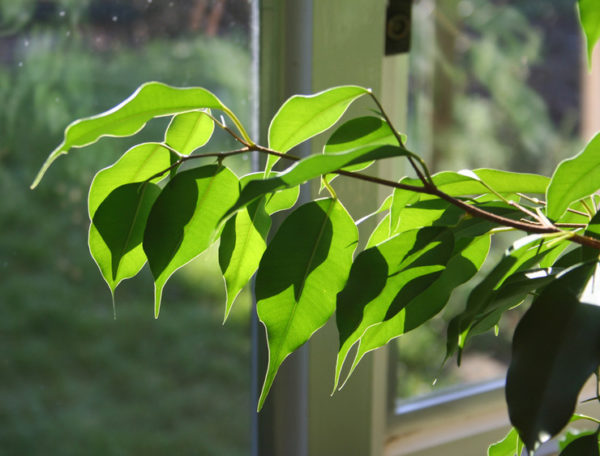
The room where Benjamin's ficus grows is often required to be aired, but do not forget that it does not like drafts. When growing and caring for the ficus of Benjamin at home, it is strictly forbidden to put it on the southern windows, otherwise the leaves will not be left behind.
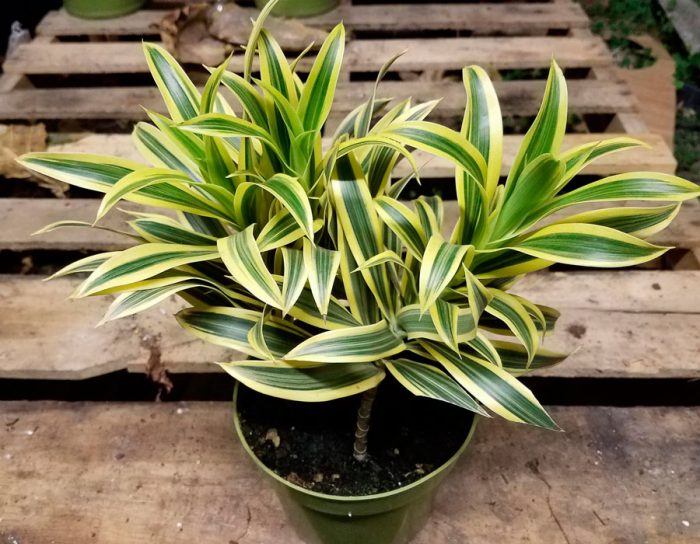 You may be interested in:
You may be interested in:Watering
It should be watered sparingly, as foliage begins to fall when the soil is waterlogged. Humidify the soil only when the soil dries. In winter, watering is done once a week, and in summer several times a week. With insufficient moisture, the foliage begins to turn yellow and fall.
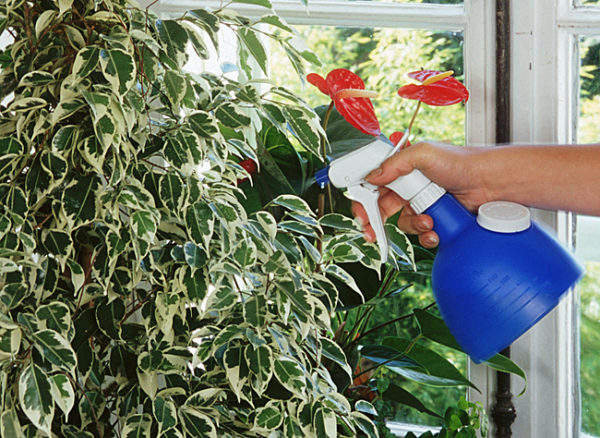
Fertilizing and fertilizers
Top dressing should be made only when the growth period passes. This mainly occurs in the spring and early fall. Make liquid fertilizer several times a month.
Transplant and pruning
Benjamin's ficus transplant and home care are recommended depending on the growth and type of plant.To improve the vital activity of the plant, it is recommended to transplant it. Young ficuses require an annual transplant, but after four years of age it can be transplanted every few years.

You can also pay attention to the following signs, which show that it is urgent to transplant the plant:
- The soil dries quickly.
- Leaves turn yellow and fall, resulting in the trunk becoming bare.
- The root system grows and begins to pass through the drainage holes and appear on the surface of the earthen coma.
- After you have purchased a plant in a store, replanting it is recommended after a few weeks. This is done to adapt to the new environment.
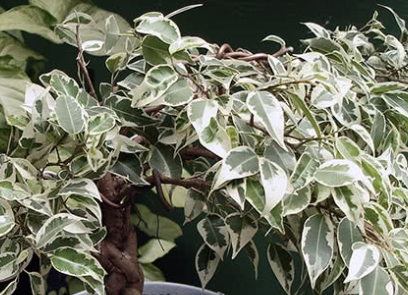
How to transplant sequentially:
- In order to pull the plant out of the flower pot without difficulty, it is necessary to water it in advance.
- Then remove the top layer of earth.
- Drainage is placed in the container at the bottom and lightly sprinkled with soil.
- Before transplanting ficus, the soil from the root system is removed.
- To adjust the watering, the capacity is selected according to the size of the root system.
- Sand must be present in the soil, and charcoal is also desirable.
- After shaking the soil from the roots, it is placed neatly in a new container.
- On all sides add soil.
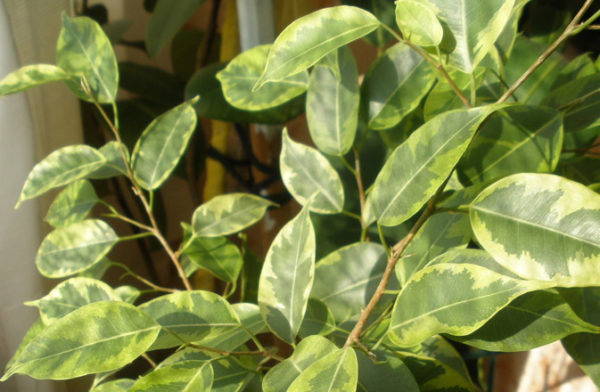
Pruning
The crown should be formed annually at ficus. Weak and diseased branches that cross others must be removed. Thanks to the thinning of the shoots inside the stems, the sun's rays illuminate the plant and help to avoid massive decay of the leaves.
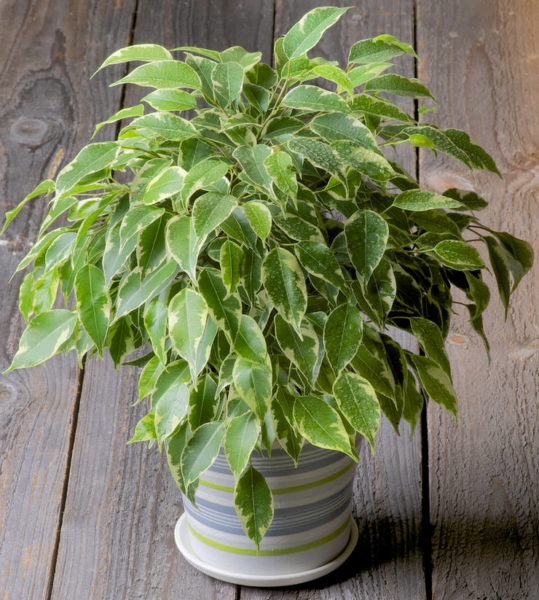
For pruning, the secateurs should be sanitized in an alcohol solution. From the main shoots, it is advisable to leave no more than 20 centimeters and having at least 5 leaves. Cut only on top of the kidney. Also, it should be under a slight bias. Milky milk may appear on the cut, which must be wiped with a cloth soaked in water at room temperature.
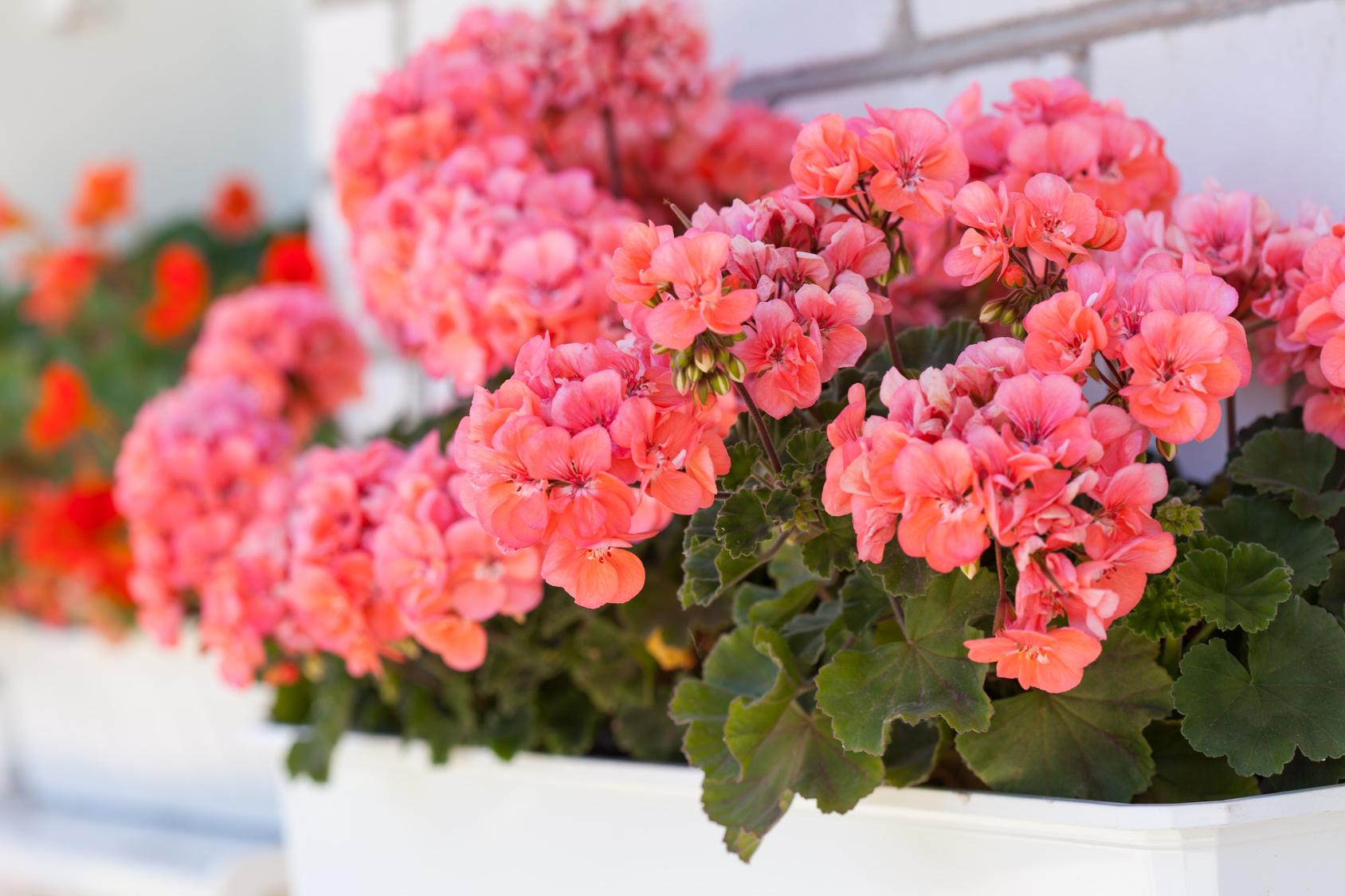 You may be interested in:
You may be interested in:Reproduction of ficus Benjamin
Ficus propagates in several ways: cuttings and layering. Let us consider in more detail each of the methods.
Propagation by cuttings
It is necessary to choose a suitable stalk, and it is also desirable that there are at least 4 unfolded leaflets on the stem. Growing ficus Benjamin and care at home do not require special skills.
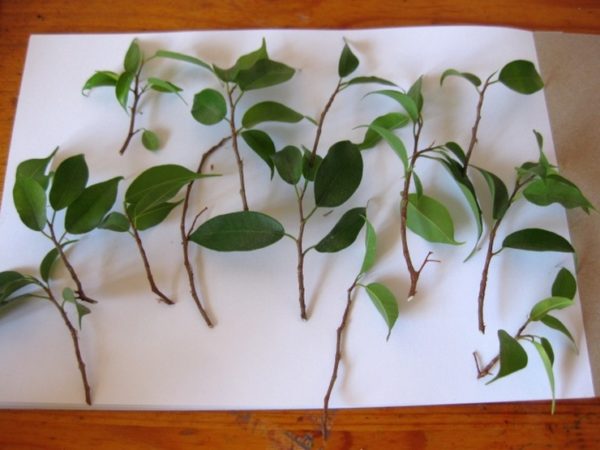
The base of the handle should be carefully cut with a sharp knife. Several incisions can be made. In order to prevent both parts of the plant from touching, put a toothpick or a match between them. This will allow you to give roots faster.
Ficus cuttings can be rooted in several ways:
- in perlite;
- in water;
- in light soil.
After the root system grows a couple of centimeters, it should be moved to a permanent place of residence.
Propagation by layering
This method is resorted to:
- with small shoots;
- if you want to get a large amount of air root system.
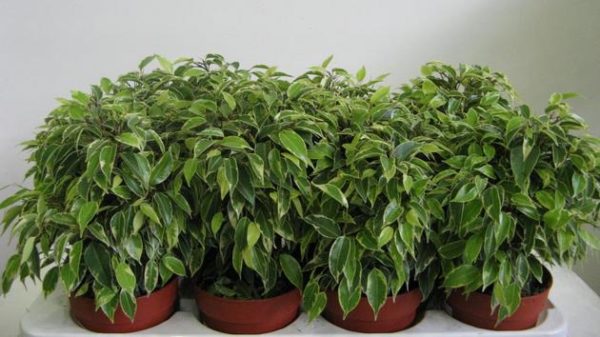
On a trunk or branch, make a cut. The exposed area should be treated with a preparation for growth, wrapped in moist soil containing sphagnum in its basis and covered with a film. It is advisable to fix the edges with thread or tape.
After the root system is visible through the film, it should be freed. It is recommended to cut a young seedling a few centimeters below the roots. Place the cut of the parent plant with charcoal.
Diseases and Pests
This plant is quite resistant to various pests and diseases. The main symptom of the disease is dropping foliage. Growing Benjamin's ficus, flower growers know that diseases can be prevented in advance.
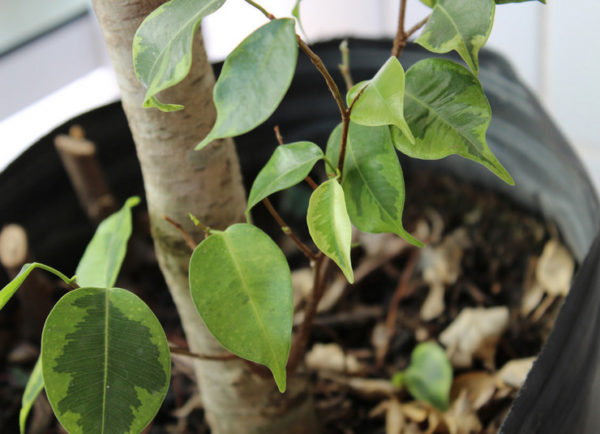
With insufficient lighting, yellowing and pallor of the leaves are observed. In this case, the plant is recommended to be moved closer to the window. When brown spots appear, the ficus, on the contrary, is moved away from lighting, since this indicates a sunburn. At low temperatures, the leaves curl, wither and fall off.
With a lack of moisture, the leaves become brown and dry. Therefore, it is important to prevent diseases in time or to treat them.
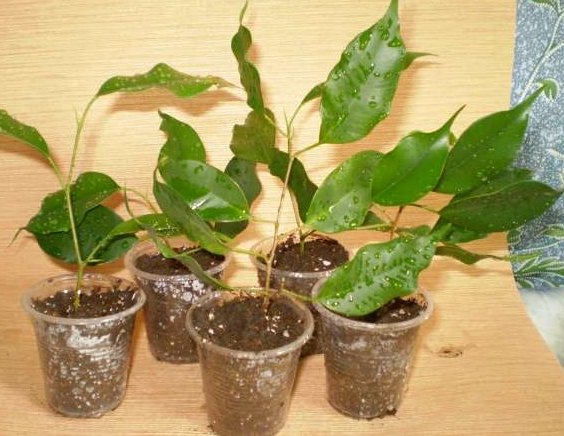
Benjamin's ficus is often affected by a mealybug, spider mite, aphid and scale insects. These pests appear at high room temperature and low humidity. The most common signs that indicate the appearance of parasites: the appearance of spots on the plates, cobwebs, swoops, foliage gradually fades, turns yellow and falls off. In order to get rid of the tick and aphids, it is enough to wipe the plant with a soap solution. To get rid of other parasites, you will need to use insecticides.
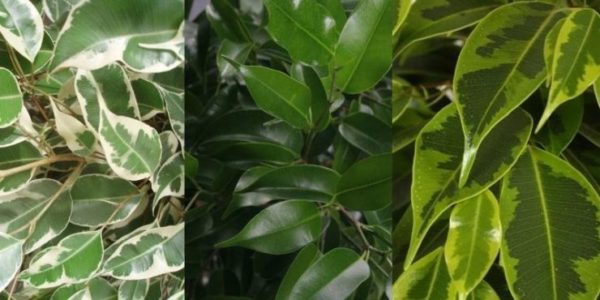
The insect covers the foliage with an oily white coating. It will take a long time to deal with it, and apply complex treatment. With frequent watering, rot appears on the root system. To do this, it will be enough to remove all rotten roots and change the earthen mixture.
 You may be interested in:
You may be interested in:Growing difficulties
Ficus is a rather moody plant. When the location of the plant changes, growth begins to slow down and fall off the foliage. Even if you sharply turn the ficus around the axis, then it begins to crumble, even completely healthy leaves fall.
Foliage drops at elevated or low temperaturesindoor air, with excessive watering and insufficient amount of mineral fertilizers.
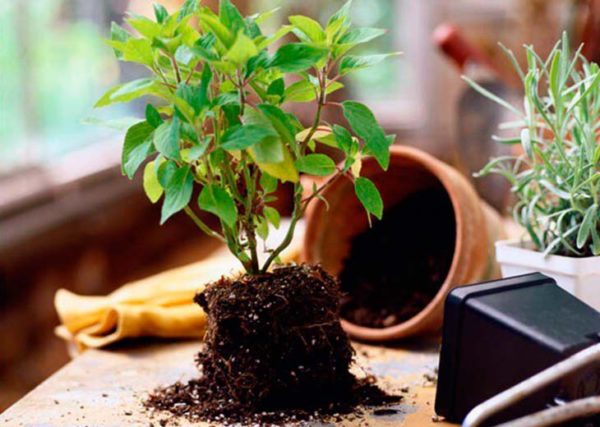
Yellowing of the foliage is observed when pests appear. Also in this case, they may fall.
In order for Benjamin's ficus not to drop leaves, it is recommended to eliminate the cause. In this case, you will not wonder why the leaves fall.




 Sow in the ground, without seedlings: 10 beautiful and unpretentious flowers
Sow in the ground, without seedlings: 10 beautiful and unpretentious flowers Platicodon planting and outdoor care
Platicodon planting and outdoor care Hosta - planting and care in the open ground in the Urals
Hosta - planting and care in the open ground in the Urals Oleander - care and growing at home
Oleander - care and growing at home